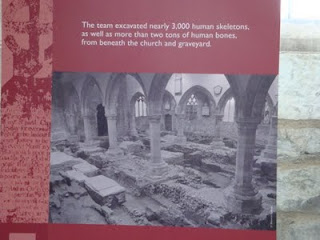Next on that tour we crossed the Humber River over a suspension bridge. I thought it was amusing that the retirement age people on the bus were excited about that. But then, if you don't take a childish delight in things, where is the fun in life?
St. Peter's is an honest-to-goodness Anglo-Saxon church, with sections of the tower built around 970 AD. It was decommissioned as a church around 1970 due to lack of attendance. On the day that we were there, it was raining (big surprise), and so the walk up to the building was damp, grey, and had the type of atmosphere you would expect for walking through an ancient graveyard.
Unfortunately for this picture, my camera automatically adjusts to dim light. Which is great if you are photographing medieval documents without a flash, but it did lose the quality of light that existed at this place on this day.
One of the gravestones reminded me of Snow White, because of its shape, and the Poe-like romantic quality of the ivy.
As you come around the corner from this, the tower comes into view.
The bottom level has the rounded arches supporting the pointed arches. The second section, which was built about ten years later, has the pointed windows. The top section was built sometime in the next century. Here's a better view:
The rest of the building dates to the 14th century. I like the wooden door within the door seen here:
The skeleton to the right just added to the feel of the place.
A view of the oldest part of the church from inside:
And then there is this very strange door. It does not match the rest of the already eclectic building. The rock work is very uneven, with stones poking out at various lengths, giving a somewhat eerie feel to it - like it was bricked up by someone in a hurry. From the outside, however, the rock has been smoothed out.
Because it is no longer a functioning church, and is owned by English Heritage, an archaeological dig was performed on the graveyard and under the flooring. The interior of the building is now a strangely cheerful, macabre museum set up of what they found.
There are signs and exhibits discussing burial practices and how they had changed over the centuries. One one interactive section you could push a button, answering the question of whether you would preferred burial or cremation (cheerful topic for a day out with the kids!) Whole skeletons were on display, as well as old coffins, bones showing particularly nasty diseases, and this gem.
This poor soul was found with his skull cut open, as is visible on the picture, but also with a wooden stake replacing the vertebrae in his neck. Hannah, a PhD that studies vampire and werewolf literature couldn't get her hands on pencil and paper fast enough.
The building was very interesting, and the grounds were beautiful, but I honestly can't decide which was creepier - the fact that there were bodies all over (well, under really) the place, or the fact that there should have been, but they had all been dug up. It was astounding, either direction.
Of course, leave it to English Heritage to take all the fun out of things...
In case you can't read the finer print, it says "Please take care as historic sites can be hazardous."










No comments:
Post a Comment